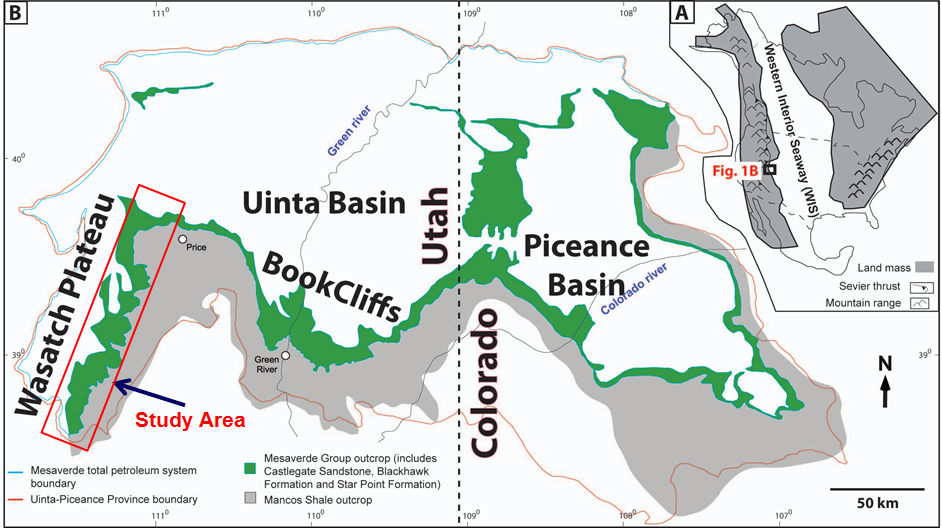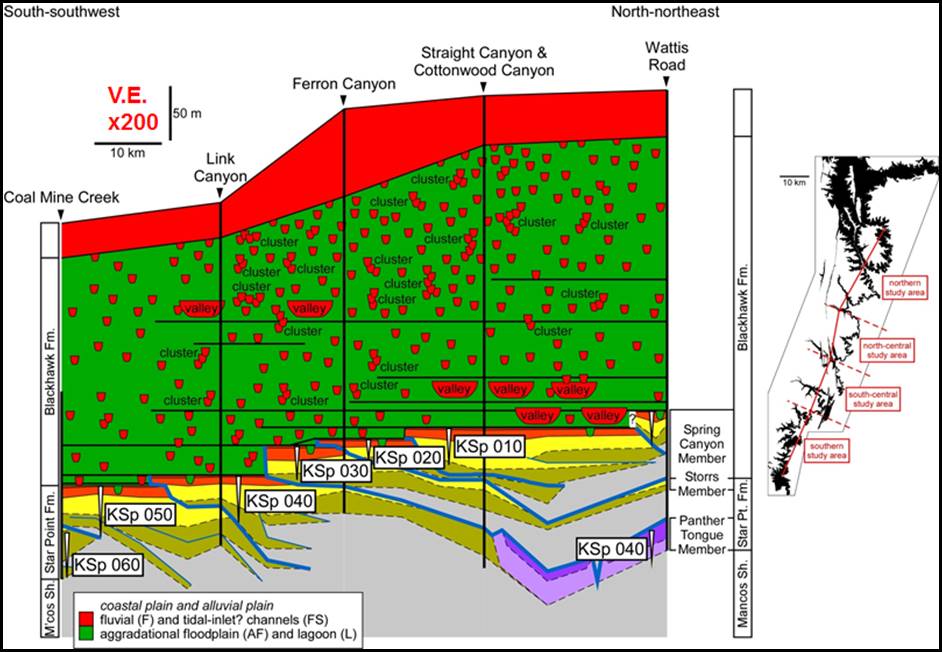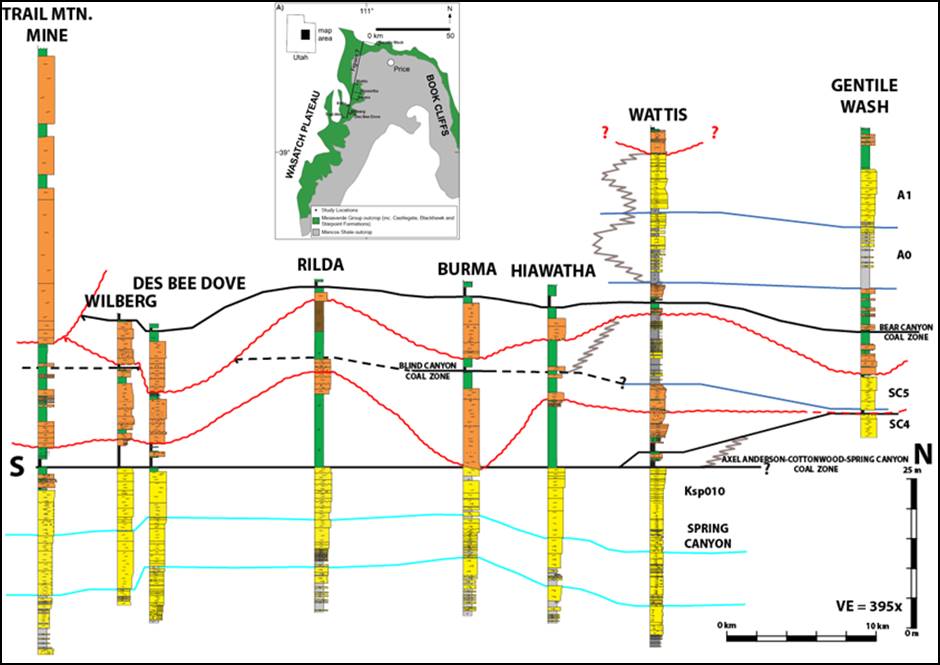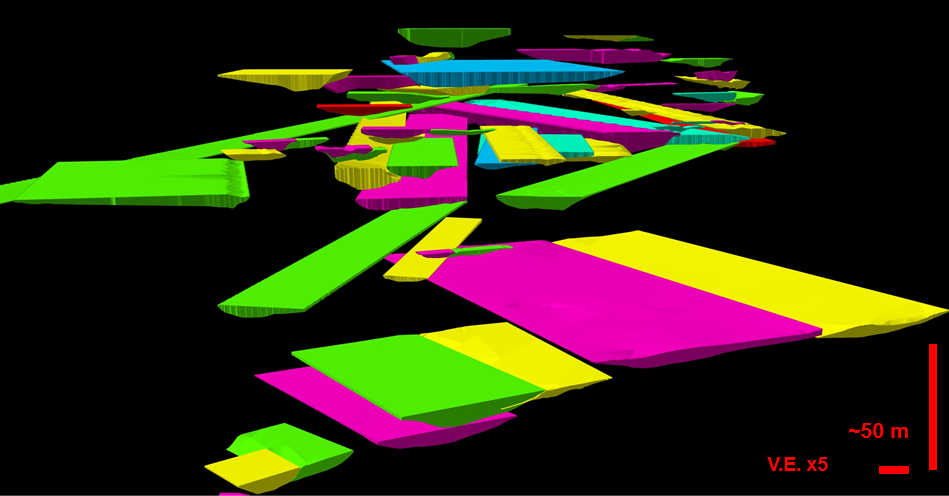Reports: DNI850310-DNI8: Sequence Stratigraphic Architecture Along Depositional-Strike in Shallow-Marine Outcrops, Wasatch Plateau, Utah
M. Royhan Gani, PhD, University of New Orleans
Current sequence stratigraphic models deal with stratal packages mostly along depositional-dip. A well-documented example of sequence stratigraphic variability along depositional-strike is largely lacking, particularly in the outcrops. This project investigates shallow-marine to coastal-plain-fluvial strata in depositional-strike-oriented outcrops in the Wasatch Plateau, which is contiguous with the dip-oriented Book Cliffs outcrops, Utah (Fig. 1). Much of the current and projected global hydrocarbon production remains in siliciclastic shallow- and marginal-marine reservoirs. Hence, this study is important to understand better the controls on these reservoirs’ architecture using outcrop analogs, particularly along depositional-strike. Moreover, this study can serve as a direct outcrop analog for producing tight-gas reservoirs in the adjacent Uinta and Piceance Basins (Fig. 1).
This PRF funding enabled PI to launch successfully a major research initiative at an early-and-critical stage of his career in a tenure-track faculty position at a PhD-granting institute. As part of this study, PI has developed effective collaboration with Gary Hampson at Imperial College London and John Howell at University of Bergen (now at University of Aberdeen). Under the supervision of PI, 4 graduate and 2 undergraduate students, and one postdoc were directly involved in various aspects of this project.
Andrew Ranson completed an undergrad senior-thesis (2010), and then defended his MS thesis in 2012 (now working at Chevron). Hiranya Sahoo completed his PhD dissertation in 2013, and now (after declining a job offer from Shell) is pursuing postdoc research under the PI. David Cross and Corey Hinyup (who completed an undergrad senior-thesis) will likely defend their MS theses in 2015. These graduate students secured many additional funding (AAPG, IAS, SEMP-GCS, and ExxonMobil-Geoscience-Grant) to support their research. This was made possible because of this PRF fund that initiated their graduate research.
This study focuses on the upper Cretaceous, from older to younger, shallow-marine Star Point Formation, coastal-plain to fluvial Blackhawk Formation, and continental-fluvial Castlegate Sandstone. These rocks are exposed in a large (~100 km), nearly-continuous section along depositional-strike in the Wasatch Plateau, Utah (Fig. 1). Each summer, fieldwork was conducted to collect various data. For example, we collected low-angle aerial photographs of the entire outcrop belt (acquired on overview flights by a light airplane), ~40 measured sections, ground penetrating radar data from a few mesa tops, and ~20 outcrop photomosaic panels with facies architectural and sequence stratigraphic interpretation. One well-core, ~300 m thick, was also logged in detail at the Core Lab of Utah Geological Survey. We generated virtual 3D outcrops of three cliff-faces using Sirovision technology. As part of our collaborative effort, a team from Bergen University collected and processed helicopter-based lidar data (~15 cm resolution) from a 3D cliff (25 km2 area) located in our study area.
This PRF-funded research resulted in numerous conference/meeting presentations and 2 peer-reviewed publications. Currently, five manuscripts are either under review or in preparation. Our main results are briefly described below:
1) The Star Point Formation consists of seven parasequences (Fig. 2) that predominantly comprise wave-dominated shoreface-to-shelf deposits. Notably, wave-dominated shoreface sandstones in each parasequence thin and wedge out over short distances (<500 m) at their updip pinchouts. The arrangement of parasequences defines an overall concave-landward shoreline trajectory with significant along-strike variations that reflect increased tectonic subsidence towards the north where a highly localized, large-volume, fluvial sediment supply produced an areally extensive (>800 km2) fluvial-dominated delta front complex (Panther Tongue).
2) We have characterized facies and sequence stratigraphic complexity at the transition of the Star Point Formation to Blackhawk Formation (Fig. 3). The nature of spatio-temporal transition of these two Formations is largely undocumented so far, particularly along depositional-strike. In the northern study area with increased subsidence, the transition from marine to continental strata is expressed by complex intertonguing of marine and coastal-plain succession. This transitional complexity progressively decreases southward, with a rather simple upward transition from shallow-marine strata to coastal-plain strata. At least two sequence boundaries (high frequency?) are correlated across the entire length of the studied outcrop belt, where each is represented as alternating incised-valley-floors and interfluve paleosol surfaces along depositional-strike.
3) For the entire Blackhawk Formation, coastal-plain stratigraphic architecture and large-scale patterns of fluvial sandbody distribution have been analyzed using a large outcrop dataset (Fig. 2). In general, the stratigraphic architecture is marked by an upward increase in the size and abundance of channelized fluvial sandbodies, which coincides with a decrease in tectonic subsidence in the upper Blackhawk Formation and overlying Castlegate Sandstone. Locally, the fills of some of the incised valleys in the lower Blackhawk Formation are controlled by autogenic processes of differential subsidence linked to underlying coal thickness variation. This suggests that autogenic sandbody depositions within incised valleys can happen during falling stage of sea-level, cautioning that all paleovalley fluvial architecture should not be automatically attributed to allogenic-modulating processes and/or to lowstand systems tract.
4) Using Lidar data and a novel approach of 3D mapping of fluvial channel sandbodies, we produced complete 3D geobodies of channelized sandstones down to individual channel-story level (single-story vs. multi-lateral) for the entire Blackhawk Formation (Fig. 4). These results show an intriguing relationship between fluvial channel sandbody types and their avulsion-generated stratigraphic stacking patterns in an alluvial-to-coastal-plain setting: single-story sandbodies are prone to vertical-amalgamation, indicating reoccupation of former channels, whereas, multi-lateral (i.e. channel-belt) sandbodies tend to exhibit compensational stacking, indicating channel avulsion to new sites on the floodplain. This suggests that channel-mobility (low for single-story and high for multi-lateral sandbodies) is an important factor in attracting vs. repelling newly-avulsed channels.
Figure 1. A) Late Cretaceous paleogeography of the North America. B) Location of the Wasatch Plateau and Book Cliffs in Utah.
Figure 2. Along-strike sequence stratigraphic framework of the upper Cretaceous strata in the Wasatch Plateau. (Thick blue lines indicate parasequence-bounding flooding surfaces).
Figure 3. Along-strike and sequence-stratigraphic correlation at the transition of the Star Point Formation to overlying Blackhawk Formation. (Blue lines are flooding surfaces and red lines are sequence boundaries).
Figure 4. 3D rendering of channelized sandbodies of the entire Blackhawk Formation using Lidar data. (Black color represent floodplain deposits. For channel-bodies, each color represents one single-storey sandbody.)















